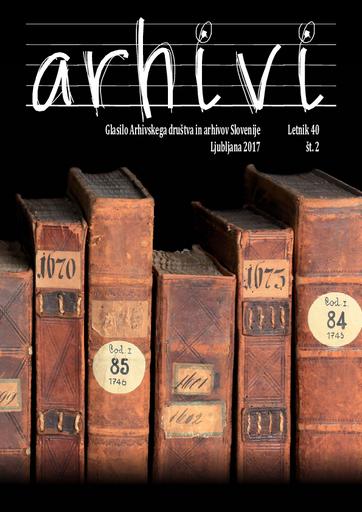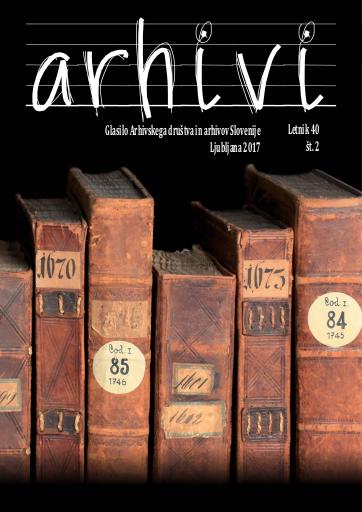/
Serijske publikacije
/
Arhivi
Slovenska pridiga baročne dobe in redovne province: med retoričnim izročilom in redovniško karizmo

Avtor(ji):Matija Ogrin
Soavtor(ji):Gregor Jenuš (gl. in odg. ur.), Dunja Mušič (teh. ur.), Petra Markuš (prev.), Tanja Martelanc (foto.)
Leto:2017
Založnik(i):Arhivsko društvo Slovenije, Ljubljana
Vir(i):Arhivi, 2017, št. 2
Jezik(i):slovenščina
Vrst(e) gradiva:besedilo
Ključne besede:ČLANKI IN RAZPRAVE, redovništvo, barok, pridiga, kapucini, frančiškani, jezuiti, avguštinci, dominikanci, ARTICLES AND PAPERS, Monasticism, Baroque, sermon, Capuchins, Franciscans, Jesuits, Augustines, Dominicans
Avtorske pravice:

To delo avtorja Matija Ogrin je ponujeno pod Creative Commons Priznanje avtorstva-Nekomercialno-Deljenje pod enakimi pogoji 4.0 Mednarodna
Datoteke (1)

Ime:ARHIVI_2017-2.pdf
Velikost:8.87MB
Format:application/pdf
Stalna povezava:https://hdl.handle.net/11686/file25397
Opis
Baroque sermon in Slovene language was created by monks. When fulfilling evangelical mission, order’s province set out the manner of friar’s work
in full accordance with the charisma of its order. On the other hand, preaching
monks took the content and form of their texts from the rich homiletic and rhetoric tradition from antiquity to modernity. With Slovenian Baroque sermon the
order’s province embedded both elements in concrete space and time of Slovenian lands where friars were fulfilling their duties. From the facts presented
above we can summarize the following conclusions.
The internal impact of a province. In every order, be it Jesuits, Capuchins,
or Franciscans, preachers were traveling from town to town, market town, and
villages. Even Janez Svetokriški was initially active in Styria, then in Vipava, Trieste, Ljubljana, and Lower Carniola; similarly as others. Because they were circulating within an order’s province amongst extremely varied dialects, province
raised monks’ awareness of the need for standard dialect, a higher linguistic
norm for proclaiming and writing sermons. Inherent to monastic needs was the
need for standard language that surpasses dialects of particular provincial areas. Awareness of the problem was clearly raised by Janez Svetokriški in Introduction of Sacrum promptuarium.
In accordance with a specific charisma of individual order, also the character of sermons varies greatly. Despite substantial differences between Franciscan and Capuchin sermons, both forms, however, address Christian as a
sensual and emotional being. Their sermons try to reflect the image to human
passions and feelings with numerous allegories and exemplary stories, thus
leading people by good example to goodness and love for God. To reach this
objective in writing sermons, a substantial literary creativity is necessary – and
these writers most certainly possess it. However, as can be seen from Jernej Basar, Jesuits gravitated toward the classical Aristotelian-scholastic philosophical
understanding of human being: man is a creature whose peak or the centre are
mind and free will that is subject to mental recognition: the mind recognizes
objective, i.e. the good, and the will follows when it strives for that good. Even
Basar’s Ignatian meditative prose leans on the human fantasy and conceptual
abilities, however, the greatest persuasive power of his texts go through human
mind more than his sensual perception.
This profound difference between Jesuit sermon on one side and Franciscan-Capuchin on the other is naturally not expressed merely in the contents,
but also in sermon’s artistic form. In this respect, it is essential that Jesuits built
their rhetoric education on antiquity, especially on Aristotle’s Rhetoric and on
the official Jesuit manual Cypriana Soareza De arte rhetorica libri tres based on
Aristotle, Cicero, and Quintilianus. This could be offset by the hypothesis that
Franciscans and Capuchins did not put as strong emphasis on the direct contact
with antiquity but is seems they welcomed rhetoric tradition more through already humanistic and current rhetoric manuals which were more modern, i.e.
Renaissance or Baroque. It is likely John Baptist and Roger of Ljubljana made
use of important encyclopaedias of Baroque rhetoric from the late 17th century,
rich with allegories, symbols, and concepts – Filippo Picinelli, Mondo simbolico,
and Emanuele Tesauro, Il cannocchiale aristotelico.
Monastic preachers thus welcomed influences and connections far outside their home order province. This field is mostly unexplored for Slovene sermon. However, it is almost beyond doubt that in Slovenian Baroque sermons different influences of authors are intertwined in various ways, perhaps St. Peter
Canisius as a possible background of Jernej Basar, and mighty interlacement of
numerous authors, on whom Franciscan and Capuchin writers base their works
– from church fathers to almost current speakers, such as Torino aristocrat and
priest Tesauro, Augustine canon Picinelli, Belgian Jesuit Engelgrave, Bavarian
Benedictine Ignatius von Trauner, and many others. A sermon is namely the
field of universal Catholic culture, hence the links of several monastic houses,
provinces, and creative spirits are intertwined in them.
Metapodatki (12)
- identifikatorhttps://hdl.handle.net/11686/41530
- naslov
- Slovenska pridiga baročne dobe in redovne province: med retoričnim izročilom in redovniško karizmo
- Slovene Sermon in Slovenian Baroque Period and the Orders’ Provinces: Between Rhetoric Tradition and Monastic Charisma
- avtor
- Matija Ogrin
- soavtor
- Gregor Jenuš (gl. in odg. ur.)
- Dunja Mušič (teh. ur.)
- Petra Markuš (prev.)
- Tanja Martelanc (foto.)
- predmet
- ČLANKI IN RAZPRAVE
- redovništvo
- barok
- pridiga
- kapucini
- frančiškani
- jezuiti
- avguštinci
- dominikanci
- ARTICLES AND PAPERS
- Monasticism
- Baroque
- sermon
- Capuchins
- Franciscans
- Jesuits
- Augustines
- Dominicans
- opis
- Baroque sermon in Slovene language was created by monks. When fulfilling evangelical mission, order’s province set out the manner of friar’s work in full accordance with the charisma of its order. On the other hand, preaching monks took the content and form of their texts from the rich homiletic and rhetoric tradition from antiquity to modernity. With Slovenian Baroque sermon the order’s province embedded both elements in concrete space and time of Slovenian lands where friars were fulfilling their duties. From the facts presented above we can summarize the following conclusions. The internal impact of a province. In every order, be it Jesuits, Capuchins, or Franciscans, preachers were traveling from town to town, market town, and villages. Even Janez Svetokriški was initially active in Styria, then in Vipava, Trieste, Ljubljana, and Lower Carniola; similarly as others. Because they were circulating within an order’s province amongst extremely varied dialects, province raised monks’ awareness of the need for standard dialect, a higher linguistic norm for proclaiming and writing sermons. Inherent to monastic needs was the need for standard language that surpasses dialects of particular provincial areas. Awareness of the problem was clearly raised by Janez Svetokriški in Introduction of Sacrum promptuarium. In accordance with a specific charisma of individual order, also the character of sermons varies greatly. Despite substantial differences between Franciscan and Capuchin sermons, both forms, however, address Christian as a sensual and emotional being. Their sermons try to reflect the image to human passions and feelings with numerous allegories and exemplary stories, thus leading people by good example to goodness and love for God. To reach this objective in writing sermons, a substantial literary creativity is necessary – and these writers most certainly possess it. However, as can be seen from Jernej Basar, Jesuits gravitated toward the classical Aristotelian-scholastic philosophical understanding of human being: man is a creature whose peak or the centre are mind and free will that is subject to mental recognition: the mind recognizes objective, i.e. the good, and the will follows when it strives for that good. Even Basar’s Ignatian meditative prose leans on the human fantasy and conceptual abilities, however, the greatest persuasive power of his texts go through human mind more than his sensual perception. This profound difference between Jesuit sermon on one side and Franciscan-Capuchin on the other is naturally not expressed merely in the contents, but also in sermon’s artistic form. In this respect, it is essential that Jesuits built their rhetoric education on antiquity, especially on Aristotle’s Rhetoric and on the official Jesuit manual Cypriana Soareza De arte rhetorica libri tres based on Aristotle, Cicero, and Quintilianus. This could be offset by the hypothesis that Franciscans and Capuchins did not put as strong emphasis on the direct contact with antiquity but is seems they welcomed rhetoric tradition more through already humanistic and current rhetoric manuals which were more modern, i.e. Renaissance or Baroque. It is likely John Baptist and Roger of Ljubljana made use of important encyclopaedias of Baroque rhetoric from the late 17th century, rich with allegories, symbols, and concepts – Filippo Picinelli, Mondo simbolico, and Emanuele Tesauro, Il cannocchiale aristotelico. Monastic preachers thus welcomed influences and connections far outside their home order province. This field is mostly unexplored for Slovene sermon. However, it is almost beyond doubt that in Slovenian Baroque sermons different influences of authors are intertwined in various ways, perhaps St. Peter Canisius as a possible background of Jernej Basar, and mighty interlacement of numerous authors, on whom Franciscan and Capuchin writers base their works – from church fathers to almost current speakers, such as Torino aristocrat and priest Tesauro, Augustine canon Picinelli, Belgian Jesuit Engelgrave, Bavarian Benedictine Ignatius von Trauner, and many others. A sermon is namely the field of universal Catholic culture, hence the links of several monastic houses, provinces, and creative spirits are intertwined in them.
- založnik
- Arhivsko društvo Slovenije
- datum
- 2017
- 01. 01. 2017
- tip
- besedilo
- jezik
- Slovenščina
- jeDelOd
- pravice
- licenca: ccByNcSa
